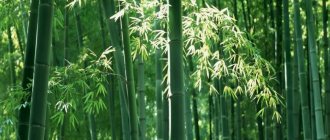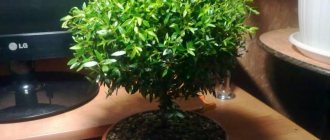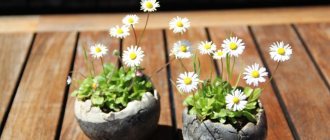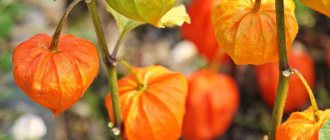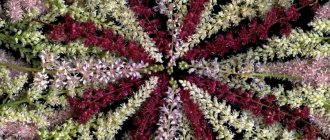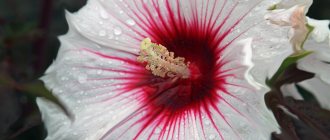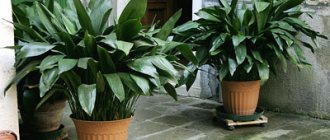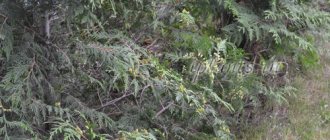Home » Flowers and plants » Indoor plants
Vladimir 03/16/2020
6011 Views 2 comments
Probably everyone has dreamed of growing something exotic at home at least once. So what prevents us from doing the same with any of the fruits? After all, there are amateur flower growers who not only grow oranges at home, but also bear fruit.
Why grow?
At home, the orange plant performs several functions:
- decorates the interior
- improves the air quality in the home
- gives children (if any) the opportunity to learn hands-on how to care for citrus fruits
- you have the opportunity to taste a real orange, freshly picked from the branch
But, meanwhile, even experienced lovers of house plants do not dare to start this plant because of its possible complexity and relative decorativeness. In addition, you need to wait several years for fruiting.
young tree
Although one can argue about the beauty of the orange tree: its foliage is very bright, glossy, and with the help of shaping you can achieve a beautiful crown. So, even without fruits, it will look very worthy among flowering and decorative foliage houseplants.
Start growing an orange not by buying a ready-made tree hung with beautiful fruits, but by planting an ordinary seed from an ordinary orange. If you lack experience, you may not be able to cope with a store-bought “miracle”.
Citrus trees imported from abroad or grown in Russian greenhouses are kept on stimulants for many years and grown at constant temperature and humidity. Therefore, once in our apartments, such plants begin to rapidly fade away. Only experienced hands can save them.
Varieties of oranges and their characteristics
Oranges differ in the type of fruit and the timing of harvest ripening. Early and late varieties of hybrid species grown in natural conditions differ from varieties of oranges with corresponding ripening periods intended for greenhouses and tub breeding. Orange fruits are:
- oval and round;
- with red and orange flesh;
- sweet, sour and bitter;
- with and without a growth above the fetus - the navel.
The most famous varieties of oranges in our country and abroad are presented in the table.
Table: the most famous varieties of oranges
| Variety name | Ripening period | Description of fruits | Other characteristics |
| Washington Navel | Early | The pulp is orange with a slight sourness | Suitable for home breeding |
| Navelina | Early | The pulp is bright orange, sweet, the peel is thin | Umbilical variety |
| Kara-Kara | Mid-early | The pulp is orange-ruby, sweet and aromatic | |
| Santina | Late | Thin-skinned, sweet, with a pronounced citron aroma | |
| Firstborn | Early ripening | Oval bright orange fruits with yellow sweet and sour pulp, contain seeds | Domestic variety |
| Salustiana | Late | Fruits with a pronounced citrus aroma and oily taste. Seedless | Grown in Brazil and Morocco |
Photo gallery: some varieties of oranges
Orange variety Washington Navel can be grown at home
The Navelina orange variety is quite large in size, with a characteristic “navel”
The Salustiana orange variety is seedless.
How did you get to Russia?
Oranges were brought to Russia from Holland in the 17th century
It was from this time that it began to be grown at home. First - in the greenhouses of noble nobles, and then in houses, in large tubs. By the way, the word “greenhouse” comes from the French “orange”, that is, orange.
Ancient greenhouses from the 18th and 19th centuries have been preserved, in which not only oranges were grown, but also many other exotic plants. By the way, we achieved flowering and fruiting of citrus fruits. Now, on the basis of greenhouses, farms are being created that, as before, are engaged in the propagation and grafting of oranges and other citrus fruits.
Many leading countries are now growing oranges: America, Brazil, Mediterranean countries, Iran, Turkey, Egypt, India and traditionally, for 3-4 thousand years, China. Orange production is not falling, but vice versa. Over the last 30-40 years alone, their production has doubled.
Landing algorithm
An orange tree seedling is transferred to open ground only in the spring, when the temperature at night remains stable at least +12°C. First, fertile soil 30-40 cm thick is poured into the hole and trampled down well.
The following algorithm of actions:
- In the prepared hole, low mounds (according to the number of seedlings) are poured from a pile of earth mixed with compost. The interval between them should be 1.5 m.
- The seedlings are placed on mounds and covered with earth around them. The base of the trunk at the very roots is not buried, leaving them 2-3 cm above the soil.
- The earth is compacted. 3-4 buckets of water (warm) are poured under each tree. Then the tree trunk circle is mulched with crushed pine bark or peat, protecting it from possible cold weather. Or, as an alternative, sow beans and soybeans near the trunk.
In order for the seedlings to tolerate transplantation into open ground well, the event should be scheduled on a humid, warm day.
Description of the species
Orange is a very attractive plant. However, like everything that cannot grow in our latitudes. They began to describe it from the beginning of the 19th century.
Botanists who have encountered orange trees in the wild have been impressed for a long time. The orange tree is a long-liver. There are specimens that have lived up to 150 years.
Let's not forget that every year trees bear a huge amount of tasty and healthy fruits. One orange in a good year can produce 30-40 thousand fruits. The amount depends on the age of the plant.
orange leaves
The height of the tree reaches 6 meters in height, at home it is 3 times less. The crown of the orange is very beautiful. The leaves are regular lanceolate in shape, like all oranges. They are glossy and dark green in color.
orange blossom
White flowers have a special beauty. They are white, less often pink, extremely fragrant and arranged in clusters, sometimes singly. The flower consists of a perianth covering many stamens and five petals.
The fruits consist of several nests, each of which contains seeds. Orange, like tangerine, unlike some other citrus fruits, is easily divided into lobes, each of which contains one or two seeds.
The orange peel has 2 layers:
- flavedo (yellow), outer
- albedo (white), internal
Inside the outer layer there are many glands that contain essential oil.
All citrus fruits have an albedo layer. But, for example, in lemon it is dense, which does not allow peeling, and in orange it is weak and loose. This allows the peel to be easily separated from the fruit.
The pulp of an orange differs, like that of all citrus fruits, in its originality and complex structure. It consists of elongated sacs containing juice. You can observe that if you do not cut the fruit, but only open it, then the juice does not flow out.
This happens because the juice sacs are not disturbed.
How to choose oranges by appearance?
Color
Clean fresh fruits have a bumpy or smooth surface. Their diameter is at least 50 mm.
Any high-quality oranges should have an even, bright color, identical to the color of their neighbors in the box. But color cannot be considered the most important factor when selecting oranges, since some greenish ones may turn out to be quite ripe and sweet, and it is possible to turn an unripe one into bright orange artificially.
The thing is that the sweetness and ripeness of oranges does not depend on their color. Their crust turns orange when exposed to heat and sun. If the weather on the plantation is good, then the greenish fruits hanging on the trees may already have a quite sweet taste.
Of course, out of habit, people in our country, when thinking about which oranges to choose, prefer to buy yellow-orange and orange oranges, since most often the greenish specimens turn out to be tasteless. Perhaps the only exception for Russia is the consistently tasty Brazilian oranges.
Weight
Before choosing sweeter oranges, you can weigh one of them in your hand. A juicier fruit will seem heavier. If fruits are sold warm, you can check their aroma by smell - more fragrant oranges will be ripe.
By the way, large specimens are usually less sweet than medium and small ones, so you should not chase the largest fruits, unless it is a large variety of “Nevel” in itself.
Overgrown oranges are often crumbly, dry and have a rather mediocre taste. High-quality oranges can always please you with a pleasant aroma, but unripe fruit has a weak smell.
Peel
If it is embossed, then most likely it is thick, and the flesh may turn out to be dry and sour. Only Jaffa oranges will be an exception here, but they do not appear on sale here. If the pores are very small and the rind looks smooth, then the rind of this fruit is most likely thin, and the rind itself is sweet and juicy.
The body of the fetus must be elastic, without various stains and dents, the presence of mold is also unacceptable. You should avoid buying both too hard and too soft oranges.
How to grow a tree from a seed
orange seeds
You can try to plant more than just an orange from a seed. But also lemon, persimmon or avocado. You just won’t get fruit from these indoor plants. Quite beautiful trees will please the eye, but only with foliage. Citrus fruits are a pleasant exception.
Why do you need a rootstock?
An inquisitive beginner who has never planted anything is faced with the question: if you plant an orange seed, what will grow? Moreover, the orange is the most ordinary one, from the nearest supermarket. The answer is yes. We will tell you how to do this below.
But we don’t need an orange seedling, but a rootstock. What does it mean? When we buy a ready-made tree with orange fruits in a flower shop, we do not even suspect that it is grafted. In 99% of all cases, the scion and rootstock are different types of citrus fruits.
Citrus grafting
All citrus fruits are grafted, otherwise, grown from seeds, they will bear fruit late (if this happens at all) and the fruits will not be as tasty. Quite often you can hear or read on specialized forums a story whose fragments are similar.
It’s about the fact that at work there is a huge lemon (orange, tangerine) grown from a seed, which is already 15 years old (10, 20, 30). And no one has ever seen it bloom. Accordingly, this tree also never indulged in fruits.
If you want your efforts not to be in vain, immediately find a good rootstock for your future tree. They can be found through advertisements. But the search will be much more effective on specialized sites, where people who are passionate about growing citrus fruits share their experience and excess planting material.
Which citrus fruits are best to plant for rootstock?
In order for citrus fruits to bear fruit, they need to be grafted. For example, kumquat or calamondin are never planted with seeds as rootstocks. Firstly, they are too frail and take a long time to grow.
Secondly, the root system of these seedlings is very weak. Both callus take a long time to grow. In a word, they are not used in this capacity.
It is believed that the best rootstocks for orange are:
- lemon
- pomelo
- bigardia or sour orange
- grapefruit
The fact is that various factors are taken into account, such as growth rate and others. Lemons are most often used, simply because they are more accessible. Than all other types of successful rootstocks.
One-year-old lemon seedlings
Two more circumstances that are taken into account when choosing a rootstock. It must have a powerful root system in order to fully feed itself and feed the scion. And another important thing: callus should grow quickly and the wounds should heal within a short period of time.
Some people call New Georgian lemon as a successful rootstock for orange. It, like bigardia, is ready for grafting within a few months after planting. And not in a year, like a lemon.
Its root is powerful and it grows callus instantly. One of the best options for rootstock. There are many opinions regarding grafting of citrus fruits. Some people like grapefruits as a rootstock because they have fairly vigorous shoots.
Some people categorically reject them for use in vaccinations. The best way to find out who is right is to experiment with grafting yourself.
How to prepare a seedling for grafting
Previously, it was believed that the rootstock should be as thick as a pencil. Now smaller barrel diameters are allowed. Hobbyists who have achieved virtuosity in matters of grafting graft citrus fruits with a trunk as thick as a match.
For successful grafting, take one-year-old lemon seedlings or 4-5 month old sour oranges. Some people apply a higher dose of nitrogen fertilizer to help the seedlings grow faster. This should not be done.
Because exceeding the dose of any element, including nitrogen, has the same negative effect as its deficiency.
Excess fertilizer is harmful to potted plants
Among the disadvantages of this method is the increased susceptibility of the plant to fungal diseases. If the excess nitrogen is large, this will also affect the appearance of the plant: the color of the leaves and trunk will change, they curl and become stained.
The best way to grow a healthy plant is to use a complete fertilizer, which contains the entire set of basic elements and microelements. In order for the lemon to grow and develop better, you can occasionally spray it with Epin to use the plant’s internal reserves.
Watering should be moderate. The soil should be slightly moist. If there is too much water, the roots will begin to rot. Outwardly, this will not appear immediately, but such a plant as a rootstock will be of little use. After all, roots are the main organ for feeding a plant.
We prepare everything for planting
Gardener's Tool Set
For beginners, you can take lemon seeds. If you really want to grow an orange from a seed, then you can do it. Orange can also be grafted onto orange rootstock. However, you will have to wait a little longer than a lemon, about a year and a half.
In order to plant citrus seeds, we need:
Plastic cups
Containers for soil
Some people specifically buy transparent cups so that they can observe the development of the root system.
Drainage
It is used to allow excess moisture to escape through the drainage hole. In the absence of drainage, excess moisture does not come out, but accumulates in the lower layer of soil and can sour there.
Pebbles or small expanded clay are used as drainage
The latter is sold in flower shops in bags labeled “Drainage”.
Priming
It is best to use the one where the name says: “For citrus fruits.” To improve germination, you can add river sand to the soil. It must first be calcined in the oven (20-30 minutes) or in the microwave (5 minutes).
Packaged soil
If you use self-prepared soil, then you must definitely use sand. Your soil must also be calcined so that all spores of fungal infections die. It is not necessary to use highly nutritious soil for sowing.
Additionally: potassium permanganate, watering can, water for irrigation, marker for signature, plastic bag, fluorescent lamp or phytolamp.
Seeds must be pre-soaked
In order for the seed to germinate faster, you can first soak it. Seeds of any plants are soaked in a small amount of water so that it barely covers the planting material. Otherwise, the seeds may “suffocate” and not sprout.
What is better to use for planting: pots or plastic cups? There is no unity in answering this question; each method has pros and cons. But most still prefer to use glasses.
They are smaller and the soil in them will not have time to sour. As soon as the root system has entangled the entire earthen ball, you can transplant the plant into a larger container. And in a pot, the root will take a long time to master the entire volume, which will slow down the development of the above-ground part.
Planting seeds
You can plant 2 or 3 seeds in a large pot at once.
You can soak the seeds in a weak solution of potassium permanganate for 15-20 minutes to disinfect the planting material.
The landing algorithm is as follows:
- Drainage holes are made in the cup with a hot metal object, usually a nail.
- Usually 2-3 holes are enough.
- Pour drainage into the bottom, approximately 1/5-1/6 of the height of the pot.
- Then add soil.
- We leave it for several hours so that it settles.
- Usually this procedure is done simultaneously with soaking the seeds.
- Just during this time the earth will settle and it will be possible to begin planting.
- In addition to soaking for several hours, you can leave the seeds in a damp cloth to germinate.
- The fabric should be washed every day in clean water and not allowed to dry out.
- After 2-3 days, the seeds (or seeds) can be planted.
- Before planting, make a small depression in the center of the pot or glass and spill a little water.
- The soil should be only slightly moistened, but in no case should the so-called “swamping” be allowed, when the soil turns into mud.
- If the soil has settled too much, add fresh soil.
- Plant the seed to a depth of 2-3 centimeters.
- After planting, sprinkle loose soil on top and do not water again.
- There should be enough moisture.
- If the seed has a “beak”, that is, a small sprout, when planting, point it down, this is the root, the cotyledon leaves will appear later.
- After planting, cover the cup with a plastic bag.
- There should be space between the soil surface and the bag.
- A so-called mini-greenhouse is formed.
- The air humidity in it should be increased to speed up germination.
- Shoots will appear in 2-3 weeks.
- How quickly this happens depends on many factors.
- First of all, this is pre-sowing treatment.
- If you pre-soaked and germinated your seed, then you may be pleased with the seedlings within a week.
- If there is no time, they can also plant dry seeds.
- In the best case, the sprout will appear in a month.
- Until this time, you can keep the pot even in a dark place.
- The main thing is to check it regularly, at least three times a day.
- The bag must be removed at least once a day and ventilated for 15-20 minutes.
- You also need to monitor the soil and seedlings.
- As soon as a sprout appears, the bag must be removed and the plant placed in the sun or under a lamp.
- You can wear the bag at night for some time, for example, a week.
When germination, the soil should always be slightly moist. Check not the surface of the soil, but a little deeper. Place your index finger on 2 phalanges. If you feel damp, then everything is in order, you can wait with watering.
Home care
Oranges grow at home in spacious pots or tubs, but in a well-lit place. From the photo you can determine which pot you will need. Caring for a home tree includes watering, maintaining the desired temperature, and fertilizing.
Domestic varieties of orange trees are viable up to 70 years, but if you deprive it of winter dormancy, it will not live longer than 4 years. When grafting is planned, a twig from a fruit-bearing tree can be wrapped in a damp cloth and stored in the refrigerator for up to a month.
Spraying and watering
Spraying the tree is required if there is insufficient humidity in the room. Watering is carried out based on the soil moisture in the tub. 1-2 times a week is enough. But the tree needs to be watered abundantly so that the soil is well saturated with moisture, but does not float in water.
Irrigation is carried out with warm liquid when the top layer of soil dries out. In winter, watering is reduced.
If possible, it is recommended to take melt water. Tap water is first settled or softened with acetic or citric acid. You also need to check that there is no stagnation of liquid. Therefore, after watering, excess water is drained. The tree is sprayed monthly with warm water to wash away dust and dirt.
Top dressing
Varieties for home cultivation must be fed from the beginning of spring to the end of October. A special complex fertilizer for citrus crops is applied to the soil at intervals of two weeks. Or instead, prepare the nutritional composition yourself.
This mixture includes potassium salt, phosphorus and nitrogen fertilizer (10 g/25 g/20 g). If the tree does not tolerate fertilizers well, then you need to rinse the soil with clean water and switch to foliar feeding. They are made in ready-made formulations, 2-3 times a year. Or choose fertilizers from another manufacturer.
Trimming
Pruning is carried out to increase the amount of harvest. The event is carried out when the orange reaches up to 30 cm in height. In spring, the main shoot is cut to 25 cm. Only 3-4 of the strongest side shoots are left on the trunk. After the increase, only two second-order branches are retained.
The next ones come from them and then fruit-bearing branches begin to form. Next, the crown is trimmed as it grows, removing old and empty branches. In the first year, the tree is deprived of all ovaries and flowers. This helps it get stronger faster and accelerates the growth of the seedling.
Topping
Oranges grow (the photo shows the size of an adult tree) at first without pinching. They should give their first shoots. After pruning, when 3-4 second branches remain, they are pinched so that branching continues. In a year the growth will begin. Then pinching is done again. It is repeated until fruit-bearing branches appear - up to 4-5 times.
Transfer
The sprouts are transplanted in the spring, when two true leaves appear on them. To do this, choose a pot with a diameter of 8-10 cm. Special soil for citrus fruits or a mixture of garden soil, sand, peat and humus (2:1:1:1) is poured into it.
For an indoor orange tree, the best soil is dug from under oak and tall nettles.
The orange tree does not tolerate picking well due to its sensitive root system. Therefore, the transplant is done together with a lump of earth. The root neck is not buried; it must remain on the surface. Then subsequent transplants are done at intervals of 2-3 years.
The tree is transferred to a larger pot or tub. But they should increase gradually. If you immediately plant a tree in a large pot, it may get sick and die. Once an orange reaches 10 years of age, it is no longer replanted. It is enough to remove and change the top layer of soil.
Optimal conditions
Orange trees are heat-loving, so they will not take root in the middle zone. They are not suitable for climates where the temperature drops to –6°C or lower. With this cold, the branches are already freezing. If the temperature drops even lower, the tree dies. Therefore, in cool climates it is necessary to prepare a shelter in advance.
Indoor varieties require conditions that are as close to natural as possible. At home, a pot or tub is placed in the southeast corner. If it is closed by a wall, then move it to another one that is maximally illuminated. But the tree should be slightly shaded so that the sun does not burn the leaves. Therefore, it is enough to curtain the window with tulle. In winter, an additional light source is directed onto the tree.
The optimal temperature in the room should be from +21°C to +25°C. If it is higher, the tree will grow faster, but will not bear fruit. If the temperature drops below the minimum value, growth and development will be delayed. In winter, indoor readings should be up to +15°C.
The room needs to be kept at high humidity. If the indicator falls below 40%, the tree will shed its leaves. This happens more often in winter, when the air becomes dry due to heating. Then additional air humidification is required - daily or 2-3 times a week. You need to place a tray under the pot or tub, which should always be filled with water.
Caring for seedlings after germination
To make an orange feel “at home,” the same conditions are created for it as in its homeland. To summarize, orange loves heat, high humidity and sun. But everything needs moderation. For successful development, we create the following conditions for an orange or lemon seedling:
Temperature
The higher the better. In the first year of development, this rule only works for the benefit. As the plant grows and blooms, the temperature will need to be regulated differently. But this will happen only in a few years.
In winter you need to reduce the temperature to 15 degrees
At the same time, do not forget about the lighting, otherwise the plant will stretch out. And the rest of the time - 20-25 C is the most comfortable temperature for an orange. At this time, especially when the temperature rises, you need to monitor the sun.
Lighting
Diffused light would be best
Orange loves sun, but direct sunlight can cause it to dry out. Especially in the first year, when a small amount of substrate in a glass dries out in half a day.
Watering
Young assistant
Regular, but no frills. For irrigation, use only settled water or after a filter.
Spraying
Several times a day, especially in the heat.
Top dressing
It is advisable to use complex fertilizers, such as nitroammophoska, which contains three main elements: nitrogen, phosphorus and potassium.
Nitroammofoska can be used throughout the development of the orange tree
As an additional recommendation, you may be advised to keep your seedlings away from drafts, otherwise they will die. To maintain high humidity, you can place cups with seedlings in trays, where you can spread wet moss.
Orange grafting
In order for an orange to bear fruit, it needs to be grafted. Let's see how to do this:
You need to prepare: rootstock, orange stalk, pruning shears or blade, polyethylene or latex (in extreme cases, you can take electrical tape).
Algorithm of actions:
- Plant it yourself using our tips, or buy a ready-made rootstock.
- Purchase a branch of a fruiting orange tree from breeders or hobbyists for grafting.
- You need to buy it on the day you plant the plant.
- Before the procedure, you need to store it in a plastic bag, wrapped in a damp cloth.
There are two methods of grafting: budding (or eye) and cuttings.
- To successfully carry out the event, you need to wait for the time of active sap flow, when the bark peels off well.
- We remove the leaves from the scion.
- After grafting, we tie the graft site and water it generously.
- After 5-10 days you need to check. If the eye does not turn black, then the bud has begun to take root.
- After 3 weeks, the bandage can be removed.
- When budding, we cut off the upper part of the rootstock only when the scion bud has sprouted and taken on an “adult” appearance.
- Budding
Vaccination schedule
Vaccination is not as complicated a procedure as it might seem at first glance. In order for everything to go well, you need to act confidently.
You can “fill” your hand on young branches of any tree or shrub. You need to take ones that are similar in diameter to the citrus fruits that interest us.
When to expect fruit
The plant is grafted, among other things, so that it bears fruit more quickly. Compare: without grafting, at best, the fruits will appear in 8-10 years. And with grafting, the wait for this event will not be long; in 3-4 years the first fragrant orange flowers will appear.
Fruit ripening in an ordinary city apartment
Sometimes a grafted plant blooms in the first year, but most often this happens later. Orange flowers are self-pollinating, so there is no need to pollinate them additionally. If at the time of flowering the room temperature is above 28 C, then urgently take measures to reduce it, otherwise the pollen becomes sterile and the fruits do not set.
The fruits ripen in approximately 8-10 months. If the plant is small, then some of the flowers can be removed. When ripe, place supports to prevent the orange from falling under the weight of the fruit.
What to do with sour oranges?
Is there anything you can do with the sour oranges you bought that were unsuccessful other than throwing them away? Sour oranges are not yet spoiled and are quite suitable for cooking. You can prepare a lot from them: compote, jam, jelly, and an excellent sauce for meat and fish dishes.
The zest of any orange is an excellent flavoring agent for baking and a homemade room deodorizer. In the latter case, pieces of zest can be hidden in a vase, and it will fill the room with a light, invigorating citrus aroma.
When using the peels of all citrus fruits, not just oranges, in cooking, it is important to remove the intervening white part that imparts bitterness.
How do you choose oranges? What is the main criterion for you when choosing these citrus fruits? Share your experience in the comments.
Applications of oranges
Oranges are good not only on the table, they are widely used in the food industry.
The main directions of their application:
The main orange product is, of course, juice. It is canned and sold to us in beautiful jars and boxes. The main problem: to distinguish a fake from a truly natural juice.
Fresh orange juice
In 2000, more than 2 million tons of orange juice were produced worldwide. Most orange juice was produced in America and Brazil. Delicious orange syrup is produced for the food industry.
It is sold in retail stores. It is also purchased in large quantities by food industry enterprises. Especially those that produce confectionery, candies, semi-finished products (pancakes with syrup), ice cream.
Antioxidant-rich essential oil is cold pressed from the peel.
There are two types - sweet and bitter orange oil. Oil made in Spain and Guinea is valued more than others.
It has a strong, characteristic aroma of fresh orange, making it popular in aromatherapy. Combines well with other essential oils, especially pine and lavender oils. Since ancient times it has been used in cosmetology as part of creams.
It has an anti-inflammatory, toning and regenerating effect for all skin types. Orange zest is widely used. It is rich in flavonoids, pectin, vitamins, and phytoncides.
Zest jam
It is used in making jam, as well as in the production of liqueurs. The remainder of the peel processing also does not go to waste and is used as livestock feed.
Main characteristics of the orange plant
Orange is a flowering, woody, evergreen plant with a continuous vegetation cycle, that is, at the same time there can be ripe and green fruits on the tree, as well as flowering baskets. The fruits of orange trees are valued for their taste and aroma. Hectares of orange plantations are cultivated in the Mediterranean, Asian countries and South America. In Southern Europe, alleys with citrus hybrids decorate central streets and squares.
Orange trees decorate streets and courtyards in Spain
Orange is an unusual plant in a number of characteristics. It is considered a long-liver and lives for more than 75 years.
Table: botanical classification of orange
| Index | Name |
| Genus | Citrus |
| Subfamily | Orange |
| Family | Rutaceae |
Why trees and fruits are interesting
This tall tree with a compact, dense crown of a round or pyramidal shape reaches a height of 10–12 m. It is characterized by remontability and grows up to 50 cm per year. There are also low varieties:
- dwarf forms grow up to 5 m;
- compact indoor trees, which look like a bush with glossy foliage, grow up to 0.8–1.0 m. Exceptional specimens that are more than 10 years old can be two meters tall.
The roots of the hybrid are located superficially and at the ends have caps with colonies of fungi instead of root hairs to absorb nutrients and moisture. The symbiosis of a plant and fungi is called mycoriosis and has a beneficial effect on the yield of citrus, since the mycelium increases the absorption surface of the roots, through which mineral compounds and water are absorbed. This feature of the root system requires artificial irrigation.
At the ends of the orange roots there are caps with colonies of fungi to absorb nutrients and moisture.
The branches have thorns and thorns up to 10 cm long. The leaves of an orange tree live for 2 years, so one plant can simultaneously have last year’s leaves, which serve to accumulate nutrients, and young ones that participate in photosynthesis. Mostly old leaves fall in February - March. The dark green citrus leaf is leathery, dense, oval in shape with a sharp tip, measures 10x15 cm and has a jagged or solid wavy edge. The glands of the orange leaf contain aromatic oils. The petioles have small winged appendages.
The orange harvest largely depends on the foliage of the plant.
If for some reason the orange tree has lost its leaves, it will not bear fruit next year. M. A. KAPTZINEL
https://homecitrus.ru/files/library/kap.pdf
Orange fruits are called hesperidium (a type of berry-shaped fruit) or bitter orange. Fruits ripen from 7 to 12 months, depending on the variety. They can be small and large, with a strongly pronounced aroma or subtle, barely noticeable. Ripe fruits weigh from 100 to 250 g, and sometimes reach 600 g. Oranges have a round or wide oval shape, similar in structure to berries. They can be multi-seeded or seedless and have a sweet and sour taste, sometimes with a specific bitterness.
Orange is a fruit and a berry at the same time
The fruits contain:
- essential oil - up to 2%;
- sugar - 9%;
- vitamins - 68%.
The pulp of the fruit is multi-locular, covered with a film and consists of 9–13 segments, separated by a partition. Fragrant juice makes up about 40% of the total volume of the fruit. The inner part consists of large succulent cells in the form of juice sacs, easily separated from each other.
The porous surface of the orange - the peel - makes up from 20 to 40% of the total mass of the fruit and has a thickness of approximately 5 mm. It is bright orange in color, sometimes with a reddish or yellowish tint depending on the variety. The surface of the peel - the zest - has a sharp ethereal aroma. The white spongy layer inside the peel is called albedo and is easily separated from the skin. Each lobe contains 1–2 seeds located one above the other.
Inside, an orange consists of three layers: peel, albedo and pulp with seeds.
Fleur d'orange - elegant orange flower
For the first time, young plants bloom and begin to bear fruit in the 3rd year of life. A snow-white basket with a large golden pistil in the middle, collected in clusters of inflorescences at the ends of the shoots, exuding a delicate aroma with notes of jasmine - this is an orange flower.
Usually the flowers of a tropical hybrid are collected in brushes of 6–8 pieces, less often - single. Orange blooms at a temperature of 16–18 degrees: in the south of Russia this begins in mid-May, some varieties bloom in early June. In Spain and Turkey, the orange tree blooms in mid-March, and in Cyprus - in March or April.
The orange flower exudes a delicate aroma
When the temperature fluctuates sharply in any direction, sensitive flowers fall off. The blooming flower is bisexual. It does not live long (no more than 5 days) and exudes a subtle, pleasant aroma. The inflorescence grows up to 5 cm in diameter when fully bloomed. It contains white-milky, sometimes with a pinkish tint, fleshy oval-shaped petals (5 pieces), tapering towards the end.
Surrounded by many yellow, heavily pubescent stamens, there is a single long pistil in the center. The flower does not fully open and the pistil remains surrounded by perianths - underdeveloped petals. There are varieties without pistils, they do not require pollination and produce fruits without seeds.
In French, "orange flower" sounds like "fleur d'orange".
The attractive essential oil of orange flowers has a wide range of cosmetic properties and has healing effects for the skin and hair. It is also called “neroli” in honor of the Italian princess Neroli, who first began to use orange flower essential oil for cosmetic purposes.
Neroli is an orange flower oil used in cosmetology.
Snow-white orange flowers were used in the Middle Ages in Europe as a traditional decoration for the bride's wreath.
Benefits of oranges
Orange is a storehouse of vitamins and other useful substances. It has a tonic effect; it’s not for nothing that Americans drink freshly squeezed orange juice in the morning. At a time when citrus fruits were transported to Europe by ship, the fruit was used as an antiscorbutic remedy.
In addition, the fruits are useful:
- prevention of hypovitaminosis
- treatment of vitamin C deficiency (160 grams contains the daily requirement of this vitamin)
- prescribed for liver diseases
- promotes better absorption of iron
- help improve the functioning of the digestive tract
- has a beneficial effect on blood vessels, thinning the blood
Oranges are especially rich in vitamin C. A little behind in quantity are vitamin B1, potassium and folic acid.
Due to the presence of a large amount of fiber, putrefactive processes in the large intestine are reduced. Dietary fiber enhances the digestion process.
One large fruit contains a daily dose of vitamin C
The fruit contains a lot (87%) of water and virtually no protein or fat, which makes the orange a very light product. Even though oranges contain 12% carbohydrates, which are in the form of simple sugars, they have a low glycemic index.
Plus: for all their benefits, they are very tasty!
How best to consume: juice or fruit
Orange juice is the leader in popularity in all countries, but, like any juice, it contains much less fiber compared to fruits. Its glycemic index increases slightly due to the lack of fiber. One glass of orange juice contains enough glucose to equal two whole oranges.
Let's remember this, it is especially useful for those who are going on a diet. Excessive juice consumption can lead to weight gain. Good quality orange juice will only benefit you if consumed in moderation. But, if you want to lose weight, it is better to eat whole fruits.
Juice or fruit?
As such, adverse effects from consuming oranges are rare. “Torture” with oranges is unlikely to harm a healthy body. Only a small number of people are allergic to citrus fruits. Pregnant women are advised to drink juices and eat the fruits themselves with caution.
Orange is highly acidic due to the content of citric and ascorbic acids and can be annoying for those who suffer from heartburn. And it doesn’t matter in what form it will be eaten.
Otherwise, this fruit, beloved all over the world, is the standard for combining business with pleasure - tasty, nutritious, simply a storehouse of antioxidants, flavonoids, vitamins, minerals, and so on. All this really helps prevent cardiovascular and kidney diseases. Overall, delicious and healthy food!
Possible diseases and pests, ways to get rid of them
The orange tree is very fond of spider mites and aphids. In both cases, the foliage curls and fades. When attacked by a tick, it becomes entangled in a web. Treatment for aphid infestation is spraying with a decoction of garlic peels or insecticidal preparations. If the roots of the tree are affected, it is replanted and further processed.
Treatment for mite infestation is spraying with a solution of boric acid (1%) up to five times.
Less commonly, mealybugs, false and common scale insects appear on it. If the tree is only slightly affected, then folk remedies will be sufficient for treatment. If the illness is serious, chemicals will be needed. Treatment is spraying with a decoction of garlic peels or insecticidal preparations.
Due to improper care, fungal infections occur. The treatment regimen includes restoring normal care, pruning affected branches, and treating with fungicides.
Diseases:
- Anthractosis. It leads to falling flowers, yellowing of leaves, and the appearance of red spots. The shoots gradually die off. Treatment - removal of dead branches, treatment with fungicides.
- Wartiness affects young shoots, fruits and leaves. Yellow spots appear on them, gradually transforming into grayish-pink warts. They grow strongly, forming a single growth. Often the entire branch dies because of this. Oranges become covered with orange spots and gradually turn brown. Treatment – at the first symptoms, diseased branches are removed and burned. Then the crown is sprayed monthly with Bordeaux mixture (1%).
- Gommosis (gum discharge) manifests itself in the form of longitudinal brown spots with a red tint. They appear on leaves and branches. The affected areas die, and a yellow-golden sticky liquid begins to ooze from the cracks, congealing in the air. Treatment - the affected areas are treated with a solution of copper sulfate (3%), covered with garden pitch on top. Activities are carried out until the disease recedes completely.
- blight is more common on grafted branches. A brown oily spot in the form of a ring appears on the seedlings. Externally, the symptoms are similar to gommosis. Treatment is treatment with copper sulfate until cure.
- Root rot causes rapid leaf loss. Treatment - removal of damaged roots, treatment of damaged roots with stimulants, complete replacement of soil. Install additional lighting and reduce the amount of watering.
Sometimes a black coating appears on the leaves. This is a sooty fungus that does not harm the tree and can be easily removed with a damp cotton swab. But if a marbled color is observed on the leaves, this is a viral infection that cannot be treated.
